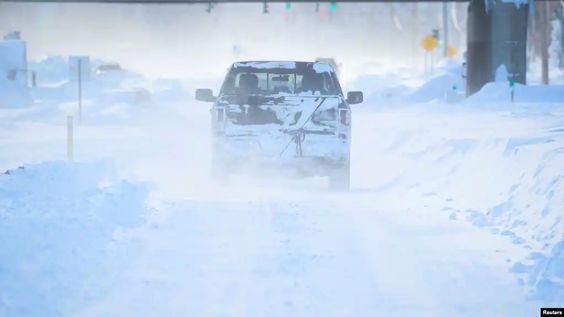World
Deadly snowstorm in the United States kills dozens and causes power outages

Western New York authorities announced Monday that a pre-Christmas blizzard that paralysed most of the country, including the Buffalo area, had resulted in 28 deaths, making it the deadliest weather-related calamity in the region’s history.
The deceased have been discovered in their residences, cars, and snowbanks. Some people lost their lives sledding. Rescue and recovery efforts are still going on Monday, as the hurricane that devastated much of the nation is now responsible for at least 48 fatalities nationwide.
As the storm tore through western New York on Friday and Saturday, it left drivers stranded, cut out power, prevented rescue workers from getting to people trapped in icy homes, and stopped cars.
Thousands of homes have been in the dark due to a lack of power, some of which were decorated with unlit holiday displays and large snowdrifts that almost buried cars on Monday.
In Amherst, New York, on December 25, 2022, a man clears snow from his driveway after a winter storm that devastated the Buffalo area.
Because the enormous storm knocked out electricity to tens of thousands of homes and businesses and locked some inhabitants inside their homes, more deaths are predicted to result from it.
From the Great Lakes in Canada to the Rio Grande near the Mexican border, there was extreme weather. Temperatures plunged well below average from east of the Rocky Mountains to the Appalachians, and around 60% of Americans were subject to some type of winter weather advisory or warning.
The bitter arctic air that is “enveloping much of the eastern half of the United States,” according to the National Weather Service, will eventually dissipate.
Hurricane-force winds and snowfall in Buffalo immobilised emergency response attempts and created whiteout conditions.
READ ALSO: Local Sources: Conflicts in the DR Congo (see Rebels Kidnapping Civilians)
Nearly every fire engine in the city, according to New York Governor Kathy Hochul, was left stranded on Saturday. On Sunday, she pleaded with residents to observe the area’s continued traffic ban. At 7 a.m. on Sunday, the National Weather Service reported that there were 43 inches (1.1 metres) of snow at Buffalo Niagara International Airport. According to officials, the airport will be closed until Tuesday morning.
Forecasters predicted an additional 1 to 2 feet (30 to 60 centimetres) of snow was possible in some regions through early Monday morning with wind gusts of 40 mph. Snow was swirling down untreated and impassable streets at 64 kph. There were two “isolated” incidences of looting during the storm, according to police reports from Sunday night.
As a result of emergency personnel not being able to reach them in time to treat their medical issues, two people died Friday in their suburban Cheektowaga, New York, homes. Mark Poloncarz, the executive of Erie County, said that the storm caused 12 deaths, including six in Buffalo, and he warned that there could be more.
According to Poloncarz, “some were found in cars, while some were located on the street in snowbanks.” “We are aware that some passengers have spent more than two days stranded in their vehicles.”
In the middle of Hochul’s description of Buffalo’s longest, most persistent blizzard, people were rushing to get to a place with heat because of the cold weather and power outages.
Ditjak Ilunga, a resident of Gaithersburg, Maryland, and his daughters were travelling to Hamilton, Ontario, to spend Christmas with relatives on Friday when their SUV became stuck in Buffalo. They struggled in the wind and snow for hours with the engine running because they couldn’t call for assistance.
By 4 a.m. on Saturday, with almost no fuel left, Ilunga took the desperate decision to brave the raging storm in order to go to a neighbouring refuge. While 16-year-old Cindy held their Pomeranian puppy and followed his footprints through drifts, he carried 6-year-old Destiny on his back.
Ilunga recalls thinking, “If I stay in this car, I’m going to die here with my kids.” When the family entered the refuge via the doors, he sobbed. It is something I will always remember.
Following the development of a bomb cyclone near the Great Lakes, which occurs when atmospheric pressure rapidly drops in a strong storm, it continued to cause problems for travelers, resulting in hundreds of flight cancellations already and more expected.This storm also produced blizzard conditions, including strong winds and snow.
As a result of the storm, power was lost in towns from Maine to Seattle. Less than 100,000 people remained without power as of 7 a.m. EDT on Monday, down from a peak of 1.7 million, according to poweroutage.us.
The 65 million customers of the mid-Atlantic grid operator were urged to use less electricity on Saturday due to the cold.
All around the nation, storm-related fatalities were reported, including a woman who fell through river ice in Wisconsin and six drivers killed in Missouri, Kansas, and Kentucky car accidents.
